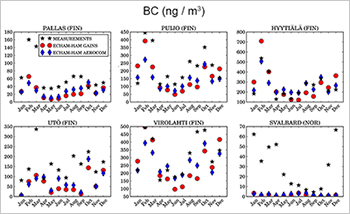

Uncertainties
In order to get some idea on the uncertainties associated with the model simulations in the MACEB project, the simulated monthly-mean black carbon concentration in surface air was compared to corresponding measured concentrations at five Finnish locations and at one site located in high Arctic (Svalbard).
Fig 1. Comparison of monthly-average black carbon concentrations measured at six locations and those modeled by the global climate model ECHAM5-HAM2 for 2007. The model simulations were made with two emission inventories: the model default emissions (blue diamonds) and emissions developed as part of the MACEB project (red circles).
The simulated black carbon concentrations are biased low at all sites, the difference being typically less than a factor two at Finnish sites and up to about an order of magnitude during the winter/spring period in Svalbard. The negative bias in near-surface black carbon concentrations when moving away from the source areas toward the Arctic has been observed in several other model studies as well. It should be mentioned that local emissions from Svalbard are not included in the GAINS model emissions, which probably contributes to the more negative simulation bias at Svalbard compared with the Finnish sites.
Uncertainties in simulated black carbon concentrations
There are many possible explanations for the simulation bias, but at the moment it seems that the highest potential lies within the wet deposition calculations. Washout of black carbon by rain is a big sink for near-surface aerosol concentrations and previous studies have shown that small changes in the calculation methods can have a huge impact. Naturally, the overall accuracy of cloud representation and precipitation intensity impacts wet deposition. In addition, other species, such as sulphate and organic carbon, influences the aging of black carbon. Thus the uncertainties coming from these species (and their emissions) will contribute to uncertainties in simulated black carbon concentrations.
Uncertainties related to top-of-the-atmosphere forcing
The lack of long-term measurement data prevents us to make a quantitative estimate of the uncertainties in the calculated aerosol forcing over the Arctic areas. Qualitatively, based on our own and other published data, we estimate an uncertainty factor of about 2 for the clear-sky top-of-the-atmosphere (TOA) forcing in the sub-Arctic areas in Europe, somewhat larger uncertainty factor for other sub-arctic areas, and still higher uncertainties for high Arctic areas. Concerning the forcing due to black carbon on snow, we estimate an uncertainty factor of about 5–10 similar to the other literature data.
Relation between forcing and Arctic warming
Uncertainties in forcing do not directly translate into uncertainties in Arctic warming. For example, a certain forcing due to black carbon on snow has been estimated to cause 2 to 4 times larger warming than the same TOA aerosol forcing. Indirect aerosol effects caused by future aerosol changes result in additional, and potentially very large, uncertainties in future Arctic warming.


